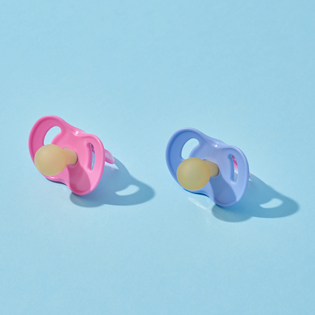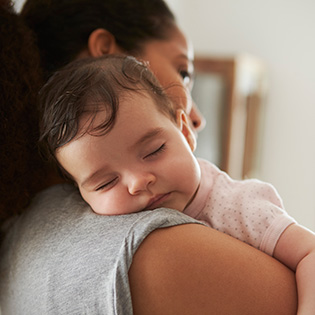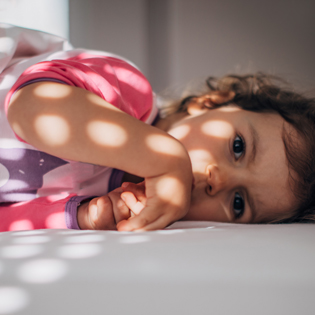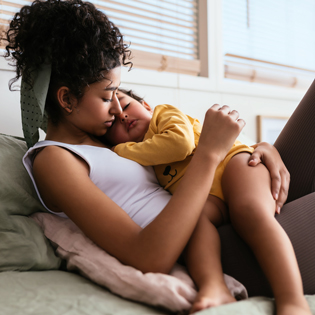Best Preemie Pacifiers
What to Expect selects products based on real-life testing conducted by staff, contributors and members our user community, as well as independent research and expert feedback; learn more about our review process. Prices and details are accurate as of the published date. We may earn commissions from shopping links.
There's a reason pacifiers are a universal symbol for babies: By offering something to suck on other than the breast or bottle, pacifiers can help soothe a fussy infant who isn't hungry, tired or in need of a clean diaper. And if your baby is born premature, pacifiers may still be a helpful tool, experts say.
"Pacifiers can help premature babies in a number of ways," says Anjuli Gans, M.D., a pediatrician at CHOP Karabots Pediatric Care Center. There are calming benefits, for one. "Premature babies in the NICU are often in a loud, busy environment," she notes. "Some research has shown that pacifiers help regulate their heart rate and oxygen levels, which can help buffer the stress of that environment."
Premature babies also often have to develop their sucking and swallowing reflexes, Dr. Gans adds, noting that pacifiers can help strengthen the muscles involved in this.
What’s more, pacifiers offered during sleep have also been linked to a lower risk of sudden infant death syndrome (SIDS).
Here’s what you need to know about choosing a pacifier for your little one, along with the best pacifiers for preemies.
How we chose the best pacifiers for preemies
- We spoke to Dr. Grans and Daniel Ganjian, M.D., a pediatrician at Providence Saint John’s Health Center in Santa Monica, California, to learn about pacifier safety and what features to look for when shopping. Per their recommendations, as well as guidance from the American Academy of Pediatrics (AAP) and Consumer Product Safety Commission(CPSC), all pacifiers on this list:
- Are molded from one solid piece of plastic
- Measure at least 3.8 centimeters across to ensure they won’t be a choking hazard
- Don’t come with any attachments, which could be dangerous
- We utilized reviews from What to Expect’s community of caregivers to learn which preemie-sized pacifiers parents felt were most comforting for their babies. Per their feedback, we made sure that every pacifier on the list satisfied the following criteria:
- Available in a small enough size for a preemie baby to comfortably use
- Easy to clean, e.g. dishwasher-safe
- Made of safe, durable materials
Preemie pacifier features to consider
When shopping for preemie pacifiers, keep these features in mind:
- Nipple shape: Some pacifier brands have an orthodontic nipple, which is intended to better support baby's oral development. Other brands may have designed the nipple to look more like the “real thing” to feel natural in a breastfed baby's mouth. Many parents find that they need to experiment with a few different brands to learn which one their baby prefers.
- Size: Not all pacifiers are the same, so start small. Look for pacifiers that are labeled for babies 0+ or 0 to 6 months, and keep an eye out for specific preemie sizing if the brand offers that.
- Easy to clean: Look for pacifiers that can be sterilized easily. Dishwasher-friendly options, which you should be able to drop in the same cleaning rack you use to wash bottle parts, are especially convenient.
Do preemies need special pacifiers?
In short, it will depend on your baby. "Some may and some may not," Dr. Gans says. "Depending on a baby's size, oral anatomy — do they have a high arched palate or a tongue-tie? — or other medical conditions, they may do better with different shapes or sizes of pacifiers." If you’re unsure, ask your pediatrician what features your child might need.
Ultimately, though, you’re looking for a pacifier small enough for your preemie’s mouth, says Dr. Ganjian. When shopping, that means looking for a pacifier labeled 0+ or 0 to 6 months.
"As long as the pacifier is small enough and baby is comfortable, then go for it," Dr. Ganjian says. "Try a few different ones. They may hate one pacifier, but love another."
Can preemies sleep with a pacifier?
Yes, preemies can sleep with a pacifier (and in fact, offering one at nap- or bedtime may help lower SIDS risk) — but it’s critical to always follow safe sleep guidelines.
Regardless of whether you’re offering a pacifier to a preemie or older baby, keep these safety tips from the AAP in mind:
- Keep pacifiers loose in the crib. Never attach a pacifier to your child’s hand or neck, to their crib or car seat, or to a lovey or stuffed animal. Pacifier clips and other such accessories that might attach to a pacifier (including ribbon, string, cord, chain, twine, leather or yarn) are incredibly dangerous.
- Look for one-piece pacifiers. Pacifiers molded from one piece of firm, solid plastic (as opposed to multiple small parts) are safest, according to the AAP. Pacifiers should also have ventilation holes.
- Check the measurements. According to the AAP, pacifiers should be at least 3.8 centimeters across to ensure they can’t fully fit into your child’s mouth.
- Never use the top and bottle nipple as a pacifier. They could come apart and pose a choking risk to your baby.
- Inspect your child’s pacifiers regularly. Make sure that the material isn’t deteriorating or torn, and if it is, replace ASAP.
- Keep size in mind. If your child continues to use a pacifier past the preemie stage (or even into the toddler stage), regularly replace them to ensure your little one is using an age-appropriate product.
When can I introduce a pacifier to a preemie?
If you’re nursing, you might choose to wait until breastfeeding has been established (usually around three or four weeks) before offering a pacifier, according to the AAP. If you’re bottle-feeding, you can introduce a pacifier any time you’d like.
Ready to shop? Look no further than these top picks.
Why Trust Us?
What to Expect is the world’s most trusted pregnancy and parenting brand for a reason. Our product recommendations are based on expert parent insight, advice from medical professionals and feedback from the millions of parents and parents-to-be in our community. Our editors adhere to the highest research and reporting standards and our team of vetted OB/GYNs, pediatricians and other health professionals ensure our recommended products are safe and effective for you and your baby.
Best Preemie Pacifier Overall
Ryan & Rose Cutie Preemie Pacifier

- Designed for preemies
- notched shield to accommodate respiratory tubes
- Not available at many retailers
Ryan & Rose pacifiers are available in a preemie size that’s designed to meet premature babies at various stages. The Preemie Kit includes two pacifiers: Preemie Tiny, which has a smaller nipple to be used up to 35 weeks, and Preemie Stage 1, which is made for babies over 35 weeks. Both feature a notched shield that can accommodate any respiratory tubes baby may need in the hospital, along with two ventilation holes. The pacifiers are lightweight, too — weighing just .6 ounces, making them one of the lightest on this list.Parents also appreciate that the small handle on the back makes it easy for caregivers to grip the paci without touching the nipple. Worth noting, though, is thatat $7 each, Ryan & Rose pacifiers are one of the more expensive models on this list.
Material: Silicone
Sizes: Preemie Tiny, Preemie Stage 1
Weight: 0.6 ounces
Best Affordable Preemie Pacifier
Dr. Brown's HappyPaci
- Affordable
- multiple pacifiers per pack
- readily available
- Some parents say the pacifiers feel heavy
Just as Dr. Brown’s bottles are popular with parents of premature babies, so are their pacifiers. The brand's lightweight silicone pacifier closely resembles the nipple on their bottles, so it will be familiar to babies already using them. (Several What to Expect Community parents note that little ones who love Dr. Brown’s bottles also seem to do well with the brand’s pacifiers.) The design wins points for its shape, too, which slightly curves away from baby’s nose and cheeks for better air flow and reduced friction. As a bonus, the HappyPaci is the most affordable pacifier on this list, coming in at just $2 each.
Material: Silicone
Sizes: 0-6 months
Weight: 1.44 ounces
Best Preemie Pacifier for Breastfed Babies
Nanobebe Baby Pacifiers

- Soft
- affordable
- open side vents for better air flow
- Some parents say they are a little small
Although the AAP recommends waiting until breastfeeding is established before introducing a pacifier, this Nanobebe paci is a particularly good choice once you feel ready.The nipple shape and super soft material is designed to mimic a breast as closely as possible, which makes it ideal for breastfed babies. Many parents of preemies say their baby was able to use it comfortably.
Material: Silicone
Sizes: 0-3 months, then 4-36 months
Weight: 1.44 ounces
Best Lightweight Preemie Pacifier
Tommee Tippee Ultra-Light Silicone Pacifier
- Affordable
- lightweight
- wide size range
- Some parents find the clear pacifiers hard to find in the dark
If you’re looking for a lightweight pacifier for your preemie, this one from Tommee Tippee is a great choice. As with Ryan & Rose pacifiers, it weighs just .6 ounces, but it’s slightly more affordable. (Several What to Expect Community members rave about the lightweight feel of these pacis.) The first stage is appropriate for premature babies, and it has an orthodontic nipple shape that helps aid a baby’s natural oral development. A nice perk: This pacifier has anti-static properties to prevent dust from settling on it. Parents also appreciate that the brand offers the same pacifier in sizes up to 36 months, so it can grow with baby if your little one really falls in love with it.
Material: Silicone
Sizes: 0-6 months, 6-18 months, 18-36 months
Weight: 0.6 ounces
Best Nighttime Preemie Pacifier
Joovy SiliNoogie Pacifier

- Comfortable
- dishwasher-safe
- Not widely available
In the middle of the night, few things are more frustrating than a lost paci in a pitch-black nursery. That’s where the Joovy SiliNoogie comes in handy: With its groovy glow-in-the-dark hue (make sure you select "Night Glow" at checkout), it’s easier to locate should it go missing in the dark. But the SiliNoogie is a solid pick for daytime hours, too. The clear, curved shield sits comfortably under your baby’s nose, and the design is a good choice to help newborns transitioning from breast to bottle. Parents also love that the silicone is resistant to picking up tastes or odors, and is top-shelf dishwasher-safe.
Material: Silicone
Sizes: 0+
Weight: 0.64 ounces
Best Orthodontic Preemie Pacifier
Chicco NaturalFit Pacifier Clear Soft Silicone
- Gum massage ring for added comfort
- durable
- widely available
- Some parents say they are a little small
Developed with leading European orthodontists, the Chicco NaturalFit is designed to help support the development of a baby’s teeth and palate with its inclined orthodontic nipple shape. The nipple also features a gum massage ring that makes for more comfortable sucking, while the tiny ridges and grooves fit seamlessly into the natural positioning of your baby's tongue. The result is added flexibility and optimal mouth closure, even for brand-new babies. Thanks to this thoughtful design, many parents of preemies say the Chicco NaturalFit was one of the only pacifiers to stay in their little one’s mouth during those early days. Note: Although this model is not dishwasher-safe, it includes a carrying case that doubles as a microwave sterilizer.
Material: Silicone
Sizes: 0-6 months (then upgrade to 6-12 months)
Weight: 1.76 ounces
Best Durable Preemie Pacifier
Philips Avent Soothie

- Doctor-recommended
- widely available
- great value
- Some babies may not like the thickness
The Philips Avent Soothie won Best Pacifier in the 2023 What to Expect Sleep Awards, and is a great choice for all babies — preemie or otherwise. With its medical-grade silicone and seamless design, the Soothie is distributed in many hospitals across the country. There are minimal nooks and crannies, making it easy to clean (it’s dishwasher-safe, too), and parents rave about how durable it is, saying it holds up well to constant wear and tear. In fact, many parents in the What to Expect Community say they started using the Soothie after getting it from the hospital and never stopped. Another selling point for many parents is the special orthodontic design, which helps support the development of baby’s teeth and gums — just make sure to upgrade to the brand’s 3 to 18 month pacifier as soon as your child hits that milestone, since the larger size is made from thicker silicone that can better withstand tiny teeth.
Material: Silicone
Sizes: 0-3 months and 3-18 months
Weight: 1.05 ounces
 Trending On What to Expect
Trending On What to Expect














































